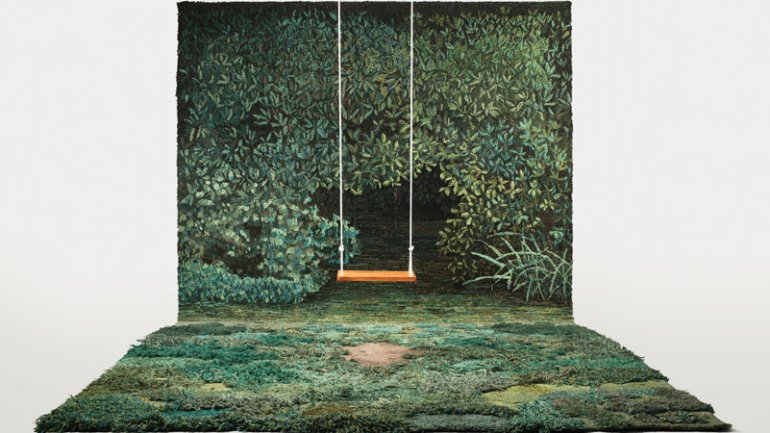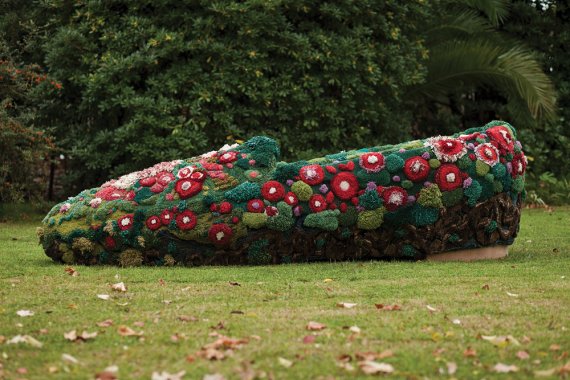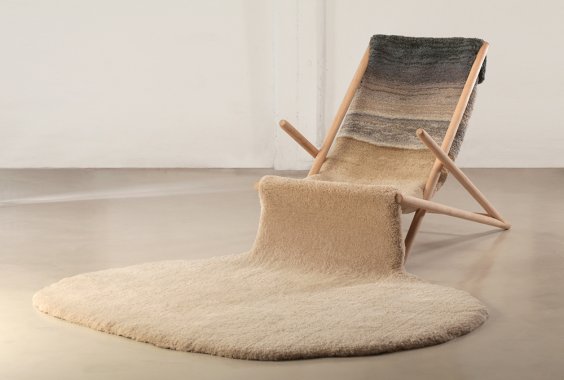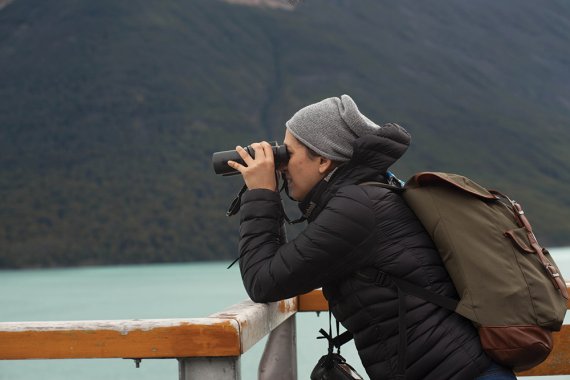Magic Carpets
Magic Carpets
Walls cannot contain Alexandra Kehayoglou’s art, which often begins as a conventional tapestry before making its way down the wall and spilling across the floor for several yards. Her hand-tufted creations are designed to be not only seen but stroked, stepped on, reclined on, and, in some cases, walked through.
The 37-year-old artist comes by her practice almost genetically. Her grandparents emigrated from Greece to Buenos Aires with a loom in tow nearly 100 years ago and established a handmade rug business that has grown into a major company. After graduating in 2008 from the National University of the Arts in painting, Kehayoglou sought a medium that could express her deep rapport with nature while using the factory’s stash of scraps. Armed with a tufting gun and mixing colors with an impressionist’s eye, Kehayoglou captures the topography of Argentina’s iconic pastizales (grasslands), deserts, glacial rivers, and sacred indigenous sites, and conjures scenic memories from her near and distant past.
Shelter for a Memory (2012) re-creates Kehayoglou’s idyllic childhood garden: A swing suspended from the ceiling faces a dense thicket of trees and hovers over a grassy, leaf-strewn ground. In Winter-Passing Chair (2018), the seat of a beach chair is draped with an image of the sea that pools onto the floor like sand, as if recalling a sun-dappled summer holiday in the cooler light of winter.
Some works are elegies for landscapes on the brink of destruction. No Longer Creek (2016) documents a rare wildlife oasis just north of Buenos Aires that was set to be demolished by developers (activists later stopped the project); Santa Cruz River (2016 – 17) responds to an Argentinian-Chinese plan to build two hydroelectric dams in Patagonia on the country’s last free-flowing glacial river, which will also flood sacred indigenous sites. Commissioned by the National Gallery of Victoria in Australia, the tapestry offers spectators a chance to sit and sprawl on the banks of a river that will soon cease to exist. As part of her site exploration, Kehayoglou kayaked down the river, collected plants, and took drone photography. Her investigation spawned a 2018 series of Prayer Rugs that each reflect a distinct slice of land.
If Santa Cruz River is a lament, Elpiniki – a 10-foot long, carpet-clad shoe covered in wool roses – is an ode to her grandmother, whom it’s named for. “It started with a family treasure – a pair of handwoven carpet shoes given to her by my grandfather’s family,” says Kehayoglou. “They were from Isparta, a city famous for its roses.” The 2014 work was made in collaboration with her life partner, José Huidobro, an experienced sailor, and is built like a boat, with a wooden frame. “I liked the idea of depicting my grandmother’s long voyage to Argentina while entwining the stories of José and me.”
Kehayoglou’s work, with its immediate beauty and unfolding allusions, resonates like poetry. Her images can inspire sadness, nostalgia, joy, and longing, and often spark a desire to step into the work and keep walking. What If All Is (2018) makes that possible. This cave recreation (inspired by two Patagonian sites, Cerro de los Indios and Cueva de los Manos) leads the viewer from darkness toward light and incorporates images of rock paintings made by ancestors of the Tehuelche people 10,000 years ago. “I wanted to follow the idea of dreams, the spiritual idea of the land, and to recognize the original inhabitants who have been so badly exploited,” she says.
Among the artist’s many reference points is the poem “Ithaka” by Constantine P. Cavafy, which urges the hero Odysseus to revel in the richness of the journey rather than focusing on the destination. Kehayoglou is similarly mesmerized by the process of creation.
“Making a carpet is a ritual, and the repetitive tufting or weaving is like a mantra. In the same way, the act of reproducing the land in a textile is a magical sensation and a way of remembering. I’m not always sure where I’m headed, but I’m immersed in nature, and that’s beautiful.”







